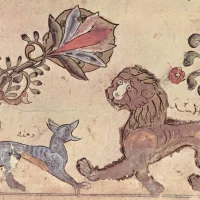Local production and consumption of beer in Africa has a long history. It is a method not only of producing a brew of key social and political importance, but also of transforming bananas, sorghum and millet into a form that can be highly nutritious. As well, the brewing process helps to decrease pollutants in the water.
This is the first of several blogs on local beer production and consumption that draw primarily on historical data, but also with some modern inputs. The following is from Sir Richard Burton’s travels in east Africa in the late 1850’s:

Sipping pombe from a gourd. Source: Kingston-Great African Travellers
In East Africa every man is his own maltster; and the “iwdnza,” or public house of the village, is the common brewery. In some tribes, however, fermentation is the essential occupation of the women. The principal inebriant is a beer without hops, called pombe.
This [drink] of the negro and negroid races dates from the age of Osiris : it is the buzah of Egypt and the ferther East, and the merissa of the Upper Nile, … and the oala or boyaloa of the Kafirs and the South African races. The taste is somewhat like soured wort of the smallest description, but strangers, who at first dislike it exceedindy, are soon reconciled to it by the pleasurable sensations to which it gives rise.
Without violent action, it affects the head, and produces an agreeable narcotism, followed by sound sleep and heaviness in the morning … Being, as the Arabs say, a “cold drink,” causing hydrocele and rheumatism, it has some of the after-effects of gin, and the drunkard is readily recognized by his red and bleared eyes.
When made thick with the grounds or sediment of grain, it is exceedingly nutritious. Many a gallon must be drunk by the veteran malt-worm before intoxication; and individuals of both sexes sometimes live almost entirely upon pombe.
It is usually made as follows: half of the grain* intended for the brew is buried or soaked in water till it sprouts; it is then pounded and mixed with the other half, also reduced to flour, and sometimes with a little honey. The compound is boiled twice or thrice in huge pots, strained, when wanted clear, through a bag of matting, and allowed to ferment: after the third day it becomes as sour as vinegar.
* The Wasukuma make it of two grains, holcus [sorghum] and bajri [millet], pounded and soaked in separate pots till fermented, and then mixed and boiled.
The ” togwa*” is a favorite drink, also made of holcus. At first it is thick and sickly, like honeyed gruel; when sour it becomes exceedingly heady. As these liquors consume a quantity of grain, they are ever expensive ; the large gourdful never fetches less than two khete or strings of beads, and strangers must often pay ten khete for the luxury. Some years ago, an Arab taught the Wanyamwezi to distill: they soon, however, returned to their favorite fermentation.
* ‘togwa,’ a sweet preparation of holcus [sorghum].
Source-Richard Burton – The Lake Regions of Central Africa, A Picture of Exploration. Vol.2 1860








![Baking Holy Bread in the Coptic Monasteries of the Eastern Desert of Egypt [qurban; 'urban]](https://dianabuja.files.wordpress.com/2015/02/one-whittemore_s-expedition-before-leaving-the-monastery-of-saint-anthony-egypt-1930-19312.png?w=200&h=200&crop=1)

















Pingback: Banana Beer and other Fermented Drinks in Africa | DIANABUJA'S BLOG
togwa is not a beer – it is fermented by lactobacilli and yeasts (which yield lactic acid and not alcohol) – in common with cheeses, pickles etc.
There is quite a lot of cutting-edge nutritional research on the nutritional benefits of togwa out of Tanzania and also Scandinavia…
LikeLike
Sorry, I’ve just seen your remark! Quite right and I did not make that clear enough. Thank you.
LikeLike
Pingback: smirnoff flavors list
Very interesting!! Does anybody have information about the introduction of european brewing into the African colonies, esp. the german pre-WW1?
LikeLike
Hello Oliver –
Indigenous beer is an African speciality – it is what colonials drank. See the following link on my blog, which has a variety of entries on local beer. Let me know if you have more questions or remarks!
https://dianabuja.wordpress.com/?s=beer
Diana.
LikeLike
Pingback: Brewing Banana Beer in Colonial Burundi « Dianabuja's Blog
Pingback: Sorghum Beer and Merchants in Mecca, in 1822 and in 1852 « Dianabuja's Blog
Pingback: Nibbles: Coffee, British orchards, Wild foraging, African agriculture, Sesame, Taro wine, African beer, Brazilian pastures, Hemp